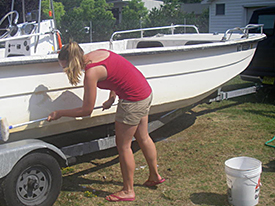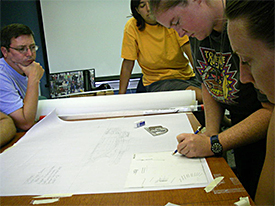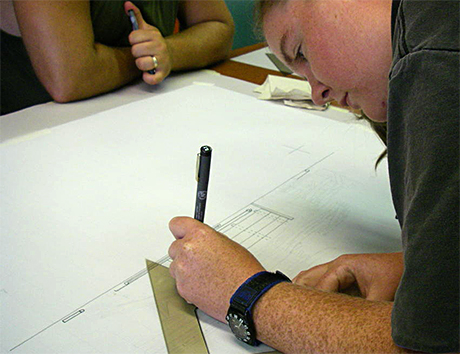
East Carolina University 2007 Field School
in Underwater Archaeology
20 June 2007
By Steve Dilk
It is hard to believe that the end of my time in Greenville is at hand. I am writing this entry over the course of our last three days officially enrolled in the field school. Once the field work was wrapped up it was up to us to finish the last of our assignments, mainly cleaning everything up and inking our drawings on the Kickin’ Bitch site.

Nadine cleans off the skiff.
I do not think I have to go into much detail about the finer points of cleaning boats, vans, dredge hoses and other equipment that has been continuously used in slightly acidic and very smelly mud for the last 3 weeks. Needless to say, you cannot have fun in the mud without getting a little bit dirty, and the equipment sure showed it.
On Tuesday, after we were done cleaning the boats, we brought them back to their home, the ECU West Research Campus. While there, we were given a tour by one of the conservators of another maritime archaeological site. This was a very illuminating experience for me because it enabled me to see another aspect of underwater archaeology. That is, of course, conservation and museum work. The finds coming from this wreck were a bit more pleasing to the eye and mind than anything we were coming up with but the point of the whole thing was the same. Preserving culturally significant finds is important and publishing what you find equally so.

The team considers the final site drawing. (large view)
The other important task left to the group and I was to finish our drawing. In New Bern, we had come together and basically agreed on the final draft drawing. Now, after a few minor adjustments, we had to “ink” the drawing onto mylar. We drew in the Kicking Bitch site along with cross sections at ten foot intervals. This work basically entails just tracing the penciled in draft form of the site onto mylar with pens. As simple as this sounds I found this to be one of the more difficult and time consuming tasks of the entire field school. It was very difficult for me to keep a steady hand to make an even line. It was even more difficult for me to have to sit patiently and wait for the ink to dry so that I could then erase what I had just drawn and not smudge the rest of the drawing. It was akin to having an itch but being unable to scratch it. No matter what I did, whenever I looked over what I had drawn I could always see something else that needed to be fixed. Vae Victis!

Mel inks the drawing.
This is about the 50th topic sentence I have come up with for this paragraph. How ironic that I would have such trouble writing the last paragraph of the last entry for this field school. At this very moment I have so much “stuff” swimming around in my head that it is very difficult to really write any coherent thoughts and put them into some sort of presentable form. And that is a good thing I think. It means that I have learned a lot about maritime archaeology (if maybe not a lot about writing). Speaking to those who may be in my position or wonder what it is like to be a maritime archaeologist, it should be clear by now that it is not always the picture perfect blue water that you are diving into and you might not be working on ships that everyone knows or thinks they know. They should understand that it is hard work but that it is also extremely rewarding. There is nothing quite like feeling around in the mud for two weeks, to seeing a side of that vessel on paper, and then to see the last close relative of that ship actually floating on the water. I think for maritime archaeologists that comes as close to a “Eureka!” moment as you can get. I was privileged to have been a part of this team and field school and certainly wish to carry on in the field.

The final draft map of the Kickiní Bitch site. (large view)
Please feel free to contact us at mua@keimaps.com with any comments, questions, or suggestions during the weeks to come.
Return to Project Journal home page.

